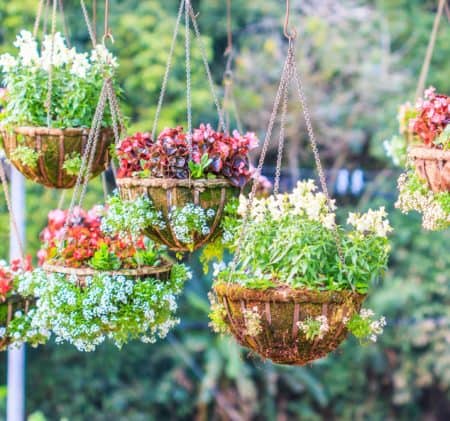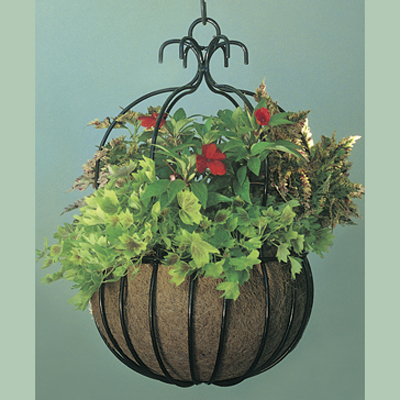Hanging baskets have a special place in my heart. They transform any space into a lively garden, allowing us to bring vibrant colors and refreshing greenery into our homes and gardens. In my journey as a plant lover, I have discovered the incredible versatility of decorative hanging baskets for plants. Whether you’re a seasoned gardener or a beginner, this guide will illuminate the various aspects of hanging baskets, including types, benefits, care tips, and everything in between.
Why Choose Decorative Hanging Baskets?
Hanging baskets serve more than just an aesthetic purpose. Here are some compelling reasons to incorporate them into your gardening routine:
- Space-Saving: Perfect for small spaces, hanging baskets utilize vertical space effectively.
- Versatility: They can be used indoors or outdoors, making them suitable for various environments.
- Aesthetic Appeal: Hanging baskets add a touch of elegance and charm to any setting.
- Accessibility: They provide easier access to plants, preventing bending and kneeling.
Types of Decorative Hanging Baskets

Not all hanging baskets are created equal. They come in various shapes, materials, and designs. Below are the main types of decorative hanging baskets:
1. Coconut Coir Baskets
Coconut coir baskets are popular due to their natural look and durability. They are made from coconut husk fibers, offering excellent drainage and aeration for plants.

Pros and Cons of Coconut Coir Baskets
| Pros | Cons |
|---|---|
| Natural and eco-friendly | Can dry out quickly |
| Good drainage | Requires regular watering |
| Attractive rustic look | May need replacement sooner than plastic baskets |
2. Metal Hanging Baskets
Metal hanging baskets come in various designs, from simple to ornate. They are durable and can withstand the elements.

Pros and Cons of Metal Hanging Baskets
| Pros | Cons |
|---|---|
| Durable and long-lasting | Can rust if not powder-coated |
| Variety of designs | May require liners for plant safety |
| Weather resistant | Can become hot in direct sunlight |
3. Plastic Hanging Baskets
Plastic baskets are lightweight and come in a variety of colors and styles. They are inexpensive and often come with built-in drainage.

Pros and Cons of Plastic Hanging Baskets
| Pros | Cons |
|---|---|
| Lightweight and easy to hang | Less eco-friendly |
| Inexpensive | May fade in sunlight over time |
| Available in many colors | Less visually appealing than natural materials |
4. Wicker Hanging Baskets
Wicker baskets offer a charming, rustic look. They are often lined with plastic for moisture retention.

Pros and Cons of Wicker Hanging Baskets
| Pros | Cons |
|---|---|
| Beautiful and stylish | Can deteriorate if exposed to moisture |
| Good for indoor use | May need regular maintenance |
| Variety of designs | Can be heavier than other options |
Choosing the Right Plants for Hanging Baskets

Now that you know the types of hanging baskets, let’s explore which plants thrive in them. Your choice of plants can make a significant difference in the appearance and health of your hanging arrangement.
Best Plants for Hanging Baskets
- Petunias: These vibrant flowers are great for sunny spots and bloom all summer.
- Ferns: Perfect for shaded areas, they offer lush green foliage.
- Spider Plants: Easy to care for and propagate, they produce beautiful “pups” that can be used to create more baskets.
- Trailing Vines: Plants like ivy or string-of-hearts add a beautiful trailing effect.
- Succulents: For those who live in warmer climates, succulents make striking options.
Comparative Table of Top Hanging Basket Plants
| Plant | Light Requirements | Watering Needs | Best Season |
|---|---|---|---|
| Petunias | Full sun | Regularly moist | Spring to Fall |
| Ferns | Indirect light | Consistently moist | All year |
| Spider Plants | Indirect light | Moderately moist | All year |
| Trailing Vines | Full sun to partial shade | Evenly moist | Spring to Fall |
| Succulents | Full sun | Allow to dry out | Summer |
Caring for Your Hanging Baskets
Proper care is essential to keep your hanging baskets healthy and looking their best. Here are some tips I’ve learned through my gardening journey:
Watering Techniques
Hanging baskets can dry out quickly, particularly in hot weather. Here are my water tips:
- Check the soil daily; if the top inch feels dry, it’s time to water.
- Water thoroughly until it drains from the bottom, ensuring the roots get moisture.
- Consider self-watering options for busy schedules.
Fertilizing Your Plants
Regular fertilization encourages robust growth:
- Use a balanced liquid fertilizer every two to four weeks during the growing season.
- Organic fertilizers can provide slow-release nutrients and improve soil health.
Pruning and Deadheading
Keep your plants looking fresh with regular maintenance:
- Remove dead or yellowing leaves to encourage new growth.
- Deadhead flowers to promote more blooms throughout the season.
Managing Pests and Diseases
Like all plants, hanging basket plants can fall victim to pests and diseases:
- Regularly inspect your plants for signs of trouble.
- Neem oil can be an effective natural remedy for many pests.
- Ensure good air circulation to prevent fungal diseases.
Creative Ideas for Decorative Hanging Baskets
Beyond the basics, there are endless ways to get creative with your hanging baskets. Here are some ideas that I’ve tried and loved:
Mix and Match Plants
Combine plants with different colors, shapes, and textures. For instance, pairing cascading petunias with upright geraniums can create a visually stunning display.
Themed Baskets
Create themed baskets like a “herbal basket” with culinary herbs such as basil, thyme, and chives, or a succulent arrangement mixing various colors and sizes.
Seasonal Swaps
Change your plants seasonally to keep your space fresh. For instance, use pansies in spring, petunias in summer, and ornamental kale in autumn.
Where to Hang Your Baskets
Location is key to maximizing beauty and plant health. Here are some popular ideas:
Porches and Patios
Packing your porches and patios with hanging baskets creates a warm, inviting atmosphere.
Indoors
Consider placing hanging baskets indoors near windows to allow for maximum light exposure.
In Trees or Pergolas
For a natural look, hang baskets from trees or pergolas to create a whimsical garden effect.
FAQs About Decorative Hanging Baskets
What are the best plants for hanging baskets?
The best plants for hanging baskets include petunias, ferns, spider plants, trailing vines, and succulents, as they thrive in vertical spaces.
How often should I water my hanging baskets?
Water hanging baskets daily during hot weather. Check the top inch of soil; if it feels dry, it’s time to water.
Can I use regular potting soil for hanging baskets?
Yes, but ensure your potting soil has good drainage. You can mix in perlite or vermiculite for better aeration.
How can I prevent my hanging plants from drying out?
Use self-watering baskets, apply a layer of mulch, and choose moisture-retentive soil to prevent quick drying.
Can I hang my baskets in direct sunlight?
Some plants thrive in full sun, while others prefer partial shade. Be sure to choose the right plants for your light conditions.
Conclusion
Decorative hanging baskets for plants offer an endless world of possibilities for enhancing your home and garden. Whether you’re looking for vibrant blooms, lush foliage, or a combination of both, hanging baskets are a versatile choice. With the right plants and proper care, you can create breathtaking displays that elevate your environment and bring joy to your gardening journey.
So, why not grab some pots, get creative, and start your own hanging basket adventure? After all, there’s nothing quite like the satisfaction of nurturing your plants and watching them thrive!